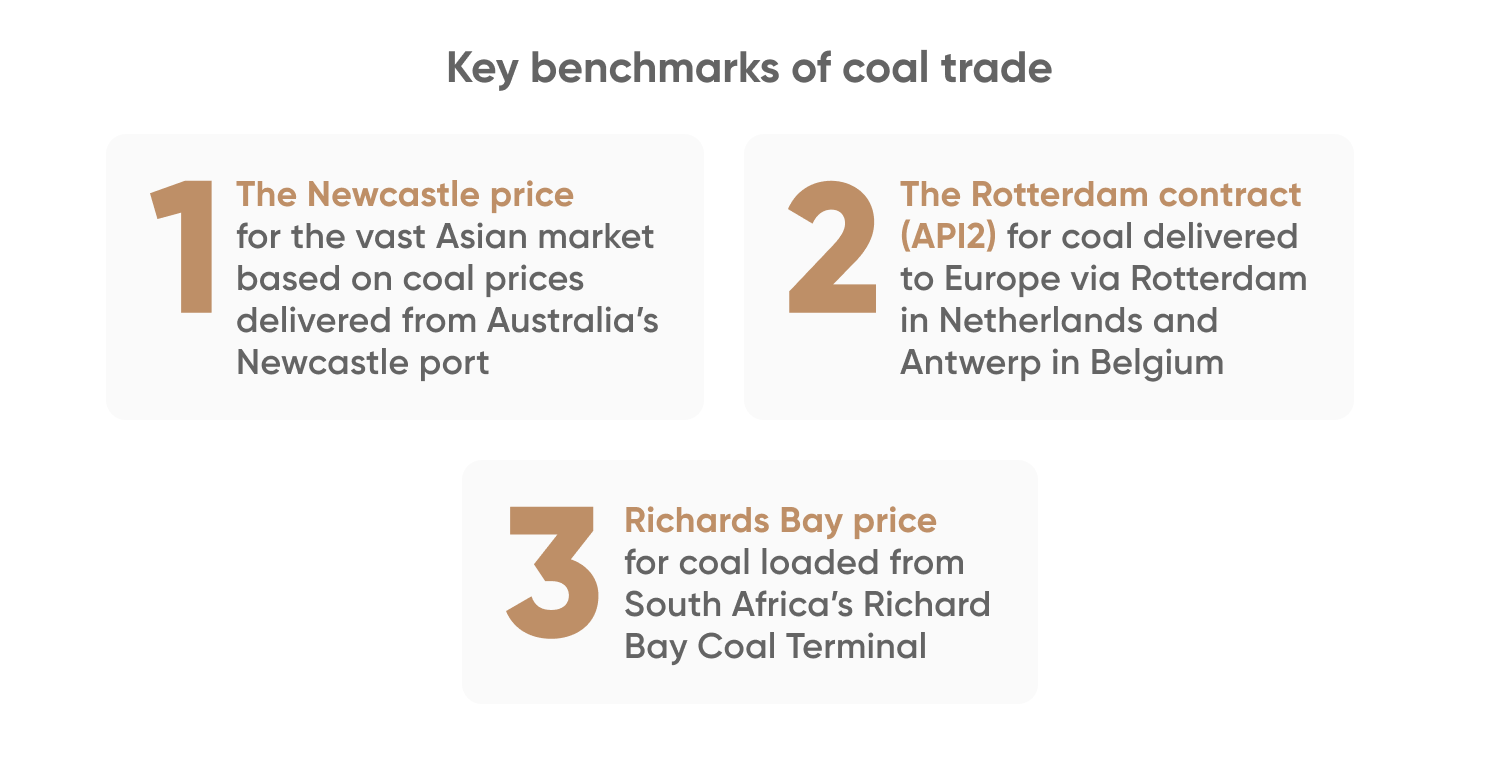Coal price forecast: How will price fare through 2023 and beyond?
Coal prices have fallen close to 50% so far in 2023. Is a rebound in store or will the downtrend continue?
Thermal coal prices have had a steep fall so far this year, after hitting record highs in early September 2022. However, prices remain high by historical standards, trending higher than they ever have prior to 2021.
Global coal consumption and demand was at an all-time high in 2022, with Europe ramping up coal-fired power plants to avert blackouts as the region diversified its energy sources away from Russian coal and gas. Post-pandemic economic recovery also drove up electricity demand in India, while poor hydropower performance prompted China to tap overseas markets.
How will thermal coal prices in the rest of 2023, as well as for the long term? In this article, we discuss the factors driving the coal market as well as the most recent coal price forecasts from analysts.
From electricity to steel: Coal’s main uses
Coal serves many functions, the most important of which is to generate electricity. The fossil fuel was formed millions of years ago from the remains of dead vegetation buried beneath layers of earth.
There are four types of coal based on their heating value, according to the United States Geological Survey. The top rank is Anthracite, also known as hard coal. It contains a high percentage of fixed carbon and a low percentage of volatile matter.
Next is bituminous coal, which has a high heating value and can be used for steel making. Third is low-to-moderate heating value sub-bituminous coal. Fourth is the lowest grade, lignite, which has low-heating value and high moisture content. Sub-bituminous coal and lignite are both used for generating electricity.
Thermal coal or power-station coal accounts for 79% of the global coal trade. The remainder is metallurgical coal, according to the International Energy Association (IEA).
There are three key benchmark prices in coal trade:

Prices vary in each region but the Newcastle price has remained the bellwether, as China and India account for two-thirds of global consumption. Trends in the global coal trade are determined largely by these two countries.
In the physical market, traders also closely watch the annual negotiation for supply contract between Australian miners and Japanese electricity generation companies. The supply contracts are typically for the Japanese financial year, which runs from April to March.
Coal is just as important as oil and gas for traders because fuel is the largest source of electricity generation and the second-largest source of primary energy. The swing in coal prices affects the global economy, just as changes in oil and natural gas prices do.
Historical coal price performance
Power-station coal enjoyed a period of elevated prices up to mid-2018, with the Newcastle coal price touching $120.8 per tonne in August 2018. Prices then began to slide due to ample supply, trend that continued well into 2019. Weaker electricity demand, lower liquefied natural gas (LNG) prices and import restrictions in China in the last quarter of 2019 added pressure to coal prices.
In Europe and the US, capacity at coal-fired power plants sank to a level unseen in decades on rising renewables and low LNG prices.
By the end of December 2019, the Newcastle coal price was hovering around $64 per tonne – about 47% below the highs in August 2018.
It plummeted to $48 per tonne in September 2020, the lowest price in 2020, as Covid-19 restrictions crushed energy demand. According to IEA, global coal demand fell by 4% in 2020, the biggest drop since World War II.
Coal prices started to recover in the last quarter of 2020 and a strong rebound in demand continued during 2021 as the global economy gradually recovered from the pandemic, with more countries lifting restrictions.
Later that year, a cold snap in northern Asia and rising demand from Europe triggered soaring natural gas prices, exacerbated by problems with gas supplies from Russia.
Russia’s invasion of Ukraine on 24 February 2022 propelled the Newcastle spot coal price to $239 per tonne, from $161 in early January 2022. It soared to a record price of $435 on 7 March on heightened concern about Russian coal. Russia is the world’s third-largest coal producer.
Coal prices plunged to the $260 level at the end of March and April, however, as China faced a new wave of Covid-19 outbreaks, forcing some cities to go into lockdowns. But the price gradually rebounded, trading above $400 a couple of times in May and July.
Flooding in Australia hampered production and transportation, and reports that China planned to end its unofficial ban on Australian coal imports also pushed up coal prices at the beginning of the second quarter.
Coal price news: prices hover near record on supply worries
On 5 September 2022, ICE’s Newcastle coal price soared to a fresh record high of $457.8/tonne on expectations of surging Europe demand. On 4 September, Russia halted gas deliveries via the Nord Stream 1 pipelione following a three-day maintenance stoppage. Russia has gradually cut gas supplies to Europe in retaliation for Western sanctions over its invasion of Ukraine.
A strike threat from US railway workers in mid-September and the persistent gas crisis in Europe after explosions in the Nord Stream 1 and unfinished Nord Stream 2 subsea pipelines at the end of September kept the Newcastle price near record highs.
The Newcastle coal price eased in the following months, falling as low as $289 on 10 November as fear of supply tightness receded. Europe stepped up imports of LNG, which helped to replenish storage capacity for the winter months.
Concerns about natural gas supply in Europe have forced countries to look for alternative sources, including returning to coal.
In December 2022, the UK approved a plan to open the Whitehaven coal mine in Cumbria, in the north-west, to produce coking coal. It would be the first coal mine in the country in three decades.
Coal prices began 2023 at $393.10, having retreated 14.1% from their all-time high in September 2023, however, the decline wouldn’t end there.
The Newcastle coal price at ICE dropped sharply towards the end of January, as the winter demand passed and Europe’s energy crisis eased. On 17 March, the price reached a year-to-date (YTD) low of $173.
As of 25 April, the price had rebounded slightly to trade at $198/tonne.

Factors driving coal prices
Coal price forecasts, like other commodities, are influenced by supply and demand. Let’s look at the coal market forecast and the factors that influence supply demand for power-station coal.
Coal demand to stay robust
Wood Mackenzie on 20 September projected Europe seaborne thermal coal demand to increase by 14% or 12 million tonnes (Mt) to 98Mt in 2022 due to the current energy crisis.
However, Woods believes Europe’s jump in coal demand will be a short-lived bump and thinks companies are unlikely to make major investment to expand infrastructure or long-term output, as global demand is expected to decline in the longer term due to environmental concerns.
In India, growing electricity demand to fuel its robust economy was expected to boost the country’s coal exports.
Australia’s Department of Industry, Science, Energy, and Resources wrote in its March report:
The agency also expected that coal demand from China, the world’s largest coal importer, would decline from 2022 as the country prioritised reducing its dependency on coal.
Coal price forecast 2023-2030: Analysts’ price targets
Given the falling demand for coal, what is the coal price forecast for the rest of 2023 and beyond?
Fitch Solutions’ coal price forecast for 2023 saw the power-station fuel trading at $190/tonne, falling from the previous estimate of $220/tonne.
In its coal price predictions, Bank of America (BofA) Global Research saw the fuel averaging $300/tonne in 2023 and $260 in 2024, dropping from estimated $334.1 in 2022. BofA’s coal price forecast for 2025 projected that thermal coal fall further to $190 in 2025 and $140 in 2026. The bank’s long-term coal price forecast expected the fuel to average $83.20/tonne beyond 2026.
As of 25 April, economic forecaster Trading Economics predicted thermal coal could trade at $187.94 by the end of the quarter, rising to $213.91 in 12 months’ time.
Neither Fitch Solutions, BofA or Trading Economics provided coal price forecasts for 2030.
When looking for thermal coal price predictions, it’s important to remember that analysts’ forecasts can be wrong. This is because their projections are based on a fundamental and technical study of the commodity’s historical price movements. Past performance is no guarantee of future results.
It is essential to do your own research and always remember your decision to trade depends on your attitude to risk, your expertise in the market, the spread of your investment portfolio and how comfortable you feel about losing money. You should never trade money that you cannot afford to lose.
FAQs
Is coal a good investment?
Fitch Solutions and Bank of America (BofA) projected coal prices to fall in 2023 and beyond. Meanwhile, Trading Economics saw coal prices increasing in 12 months’ time. However, whether coal is a suitable asset for you depends on your personal goals and the judgement drawn from your own research.
It’s important to always draw your own conclusions about a commodity’s prospects and the prospects of it meeting analysts’ goals. Remember that past performance does not ensure future returns. Furthermore, never trade money that you cannot afford to lose.
Will the price of coal go up or down?
Nobody knows for certain. The coal price direction will be determined by the impact of the ongoing Russia-Ukraine conflict on Russia’s coal supply and the ability of coal producers to lift their production to meet demand. Long-term coal price movements will be determined by global economic growth, particularly China’s economy and the global transition to clean energy.
What affects the price of coal?
Like many commodities, coal prices are affected by supply and demand. The prices of the power station fuel are driven by electricity demand, and supply in major mining countries such as China, Australia, Indonesia and Russia. Economic activity has an impact on the consumption of coal as it can drive up or reduce electricity use.
Energy transition is also increasingly playing a role in affecting coal prices. More countries are reducing the portion of coal in their primary energy sources to generate electricity, and adding more renewables, such as wind and solar power.
Weather can affect demand for heating and cause supply disruptions. Geopolitical tensions can also affect trade flows.
Should I invest in coal?
Your decision to invest in coal should depend on your risk tolerance, investment objectives, portfolio composition and experience in the markets. You should conduct your own research. And never trade with money you cannot afford to lose.